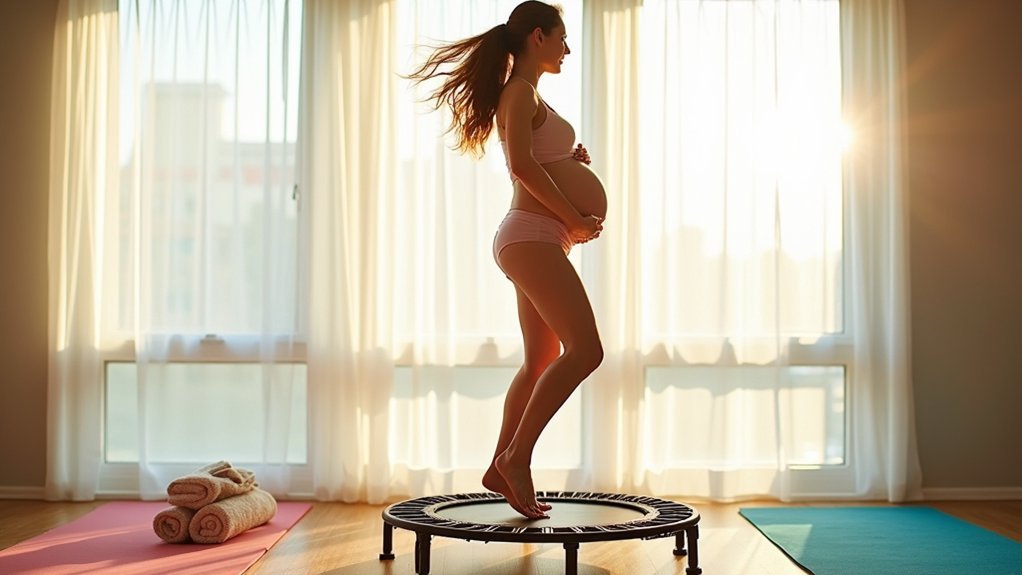Gentle bouncing exercises can greatly reduce pregnancy edema that affects 70-80% of expectant mothers. Try ankle pumps (10-15 reps twice daily), ankle circles (8 rotations each direction), seated bouncing on an exercise ball with pelvic tilts, mini-trampoline rebounding (5-10 minutes daily), calf raises (3 sets of 10-15 reps), heel bounces near a wall, and water jumps in chest-deep water. These seven techniques stimulate your lymphatic system to flush excess fluid and improve circulation throughout your body.
Understanding Pregnancy Edema and How Bouncing Helps

While pregnancy brings many joyful changes, it also introduces challenges like edema—a condition affecting 70-80% of expectant mothers. This swelling typically begins mid-second trimester as your body retains 6-8 liters of extra fluid.
The pressure of your growing uterus on pelvic veins compounds the issue, especially in your legs and feet. Bouncing exercises offer effective relief by stimulating your lymphatic system through gentle, rhythmic movements. The retention of excess water during pregnancy naturally contributes to this swelling, particularly in the lower extremities.
As your baby grows, increased pelvic pressure restricts circulation. Gentle bouncing activates your lymphatic system, naturally reducing uncomfortable swelling.
These low-impact activities enhance circulation, promote blood return from your extremities, and counteract gravitational fluid pooling.
You’ll benefit most when bouncing is combined with leg elevation, proper hydration, and sodium moderation.
Always monitor for sudden swelling that might indicate preeclampsia, and avoid bouncing if you have deep vein thrombosis or severe pelvic pain.
Gentle Ankle Bounce and Circulation Exercises
Your swollen ankles can benefit from simple rotation exercises that stimulate blood flow and reduce fluid buildup.
Try slow, intentional ankle circles in both directions while seated, keeping your movements gentle yet consistent throughout the day.
These targeted bouncing motions activate your calf muscles—your body’s natural pumps—helping to push excess fluid back into circulation and relieve uncomfortable pregnancy edema. Always consult healthcare providers before starting any new exercise routine during pregnancy, as individual circumstances vary significantly.
Ankle Rotations Matter
As pregnancy progresses, ankle rotations become an essential exercise for combating edema. Simply rotate each foot eight times clockwise and eight times counterclockwise to improve circulation in your lower extremities.
Complement these rotations by bending and stretching each foot up and down 30 times daily. This simple movement enhances blood flow and considerably reduces swelling. For ideal results, perform these exercises twice daily—perhaps morning and evening.
You can even incorporate ankle rotations while watching TV or during short breaks throughout your day. These movements help prevent muscle cramps by maintaining flexibility in your calf muscles. Remember to avoid crossing ankles while sitting or lying down as this can restrict circulation and worsen edema.
Consider adding reverse calf raises to further boost circulation. Regular ankle rotations are particularly effective because they’re gentle enough to perform throughout pregnancy while providing meaningful relief from uncomfortable swelling.
Bounce Away Swelling
Gentle bouncing exercises can effectively reduce pregnancy-related edema by stimulating your lymphatic system and improving circulation.
These movements work by using your muscles as natural pumps to help move excess fluid back into circulation.
Try ankle pumps by sitting comfortably and lifting your toes while keeping heels on the ground, then alternating with raising your heels while toes remain down.
Perform 10-15 repetitions twice daily for best results.
Toe lifts and gentle bouncing while seated are also effective options that don’t strain your joints.
Always get clearance from your healthcare provider before starting any new exercise routine during pregnancy.
These simple bouncing techniques, when done consistently, complement other activities like walking and swimming to provide thorough edema relief while supporting your overall prenatal health.
Swimming can be particularly beneficial as it provides gradient pressure similar to what compression stockings offer, helping to reduce swelling naturally.
Mini-Trampoline Rebounding for Pregnancy Swelling

Mini-trampoline rebounding offers pregnant women a gentle yet effective way to combat edema through enhanced lymphatic circulation.
You’ll need to verify your rebounder’s weight capacity and always use stability handles when performing simple movements like heel lifts or gentle bounces that stimulate fluid movement without jarring your joints. The low-impact nature of rebounding makes it particularly suitable for pregnant women seeking relief from edema while minimizing stress on their changing bodies.
Start with just 5-10 minutes of rebounding daily, always after obtaining medical clearance from your OB/GYN, especially if you have any high-risk conditions.
Safe Rebounding Techniques
While experiencing pregnancy-related swelling, mini-trampolines offer an effective solution that gently stimulates your lymphatic system.
Before starting, consult your healthcare provider to verify rebounding aligns with your specific pregnancy needs.
Choose a rebounder with safety handles and confirm its weight capacity supports pregnancy changes. Keep your bounces gentle—just 1-2 inches high—with soft knee bends to absorb shock and reduce pelvic floor pressure. Maintain controlled landings with feet parallel on the center of the mat.
Limit sessions to 10-20 minutes daily, focusing on consistency rather than duration. Alternate gentle vertical bouncing with marching in place, but avoid high knees or twisting motions. The rebounding technique is particularly beneficial because it’s easier on joints than walking or running while still providing effective lymphatic circulation. If you feel dizzy, stop immediately and hydrate.
For maximum edema relief, elevate your feet after rebounding and consider adding ankle circles during your routine.
Circulation-Boosting Bounce Routines
To maximize edema relief during pregnancy, structured rebounding routines specifically designed for circulation can dramatically reduce uncomfortable swelling. Focus on gentle, rhythmic movements that stimulate lymphatic flow without stressing your joints. The ultra-elastic bungees of quality mini-trampolines provide gentle rebound effects that are particularly safe and effective during pregnancy.
| Routine Type | Duration | Benefits |
|---|---|---|
| Low-Impact Vertical | 5-7 min | Promotes general lymph movement |
| Heel-Toe Lifts | 3-4 min | Enhances calf muscle pumping |
| Arm Circles | 2-3 min | Activates axillary lymph nodes |
| Pelvic Tilts | 3-4 min | Reduces lumbar swelling |
| Ankle Flexions | 3-5 min | Targets lower extremity retention |
For ideal results, perform these routines 2-3 times daily in 10-20 minute sessions rather than one long session. Always conclude with five minutes of elevated legs to maximize fluid redistribution and maintain moderate intensity (40-60% max heart rate).
Trampoline Safety Precautions
Safety becomes paramount when incorporating mini-trampoline exercises into your pregnancy routine for edema relief.
Always choose a mini-trampoline with a non-slip base and sturdy frame to prevent tipping, preferably one with bungee cords instead of metal springs to reduce joint strain.
Limit your bouncing height to 2-4 inches maximum and maintain a hip-width stance for ideal balance. Engage your core and pelvic floor muscles during each gentle rebound. If you’re feeling unsteady, use a wall or rail for support.
Before starting, consult your obstetrician for approval, especially if you have a high-risk pregnancy. Be especially cautious during later trimesters when your center of balance is significantly altered. Stop immediately if you experience dizziness, pain, or contractions.
Keep sessions short—10-15 minutes maximum—with frequent breaks, and always stay hydrated to prevent overheating.
Seated Bouncing Ball Exercises for Third Trimester Relief

As the third trimester brings increased fluid retention and discomfort, seated bouncing ball exercises offer significant relief for expectant mothers struggling with pregnancy edema. The rhythmic bouncing stimulates circulation while reducing fluid pooling in your ankles and feet.
For maximum benefit, try these targeted movements:
- Gentle bouncing with pelvic tilts – Activates core muscles while promoting lymphatic drainage.
- Side-to-side hip rocking – Improves venous return and reduces swelling severity.
- Circular hip rotations – Eases tailbone discomfort while loosening tight hip muscles.
- Forward leaning bounces – Redistributes weight off your pelvis while stretching your lower back.
Ensure proper positioning with knees slightly lower than hips and feet flat on the floor for stability during these exercises. Regularly engaging in these activities helps alleviate swollen ankles that commonly develop in the later stages of pregnancy.
Standing Calf Raises and Heel Bounces
Standing exercises offer powerful relief for pregnancy edema when seated options aren’t enough.
Calf raises directly strengthen the gastrocnemius and soleus muscles that pump fluid upward from your legs, countering gravity’s effects and the uterine pressure on pelvic veins.
To perform calf raises, stand flat-footed and slowly lift your heels for two seconds, then lower. Complete 3 sets of 10-15 repetitions daily. Swelling typically occurs in later stages of pregnancy, making these exercises particularly beneficial as you progress in your journey.
For heel bounces, stand near a wall for support, then gently bounce with small 1-2 inch movements for 30-second intervals, repeated 5-10 times daily.
Always maintain proper form, avoid rapid movements, and wear compression socks to enhance benefits.
Pair these exercises with ankle rotations, post-workout elevation, and proper hydration for maximum edema relief throughout your pregnancy.
Safe Bouncing Techniques to Reduce Foot and Ankle Swelling
Gentle bouncing movements offer significant edema relief during pregnancy by stimulating lymphatic flow and reducing fluid buildup in your feet and ankles.
These low-impact exercises can be safely performed with proper technique and appropriate support. Starting your routine with deep breathing exercises can enhance the effectiveness of bouncing activities by initially activating your abdominal lymph nodes.
- Mini trampoline bouncing – Try seated rebounds on a mini trampoline for lymphatic stimulation, but get your provider’s clearance first.
- Water-based bounces – Perform gentle jumps in chest-deep water where buoyancy reduces gravitational pressure on swollen limbs.
- Compression-enhanced activity – Wear 15-20mmHg knee-high compression stockings during bouncing exercises to prevent fluid pooling.
- Stability ball bounces – Do seated mini-bounces on an exercise ball to engage your core while mobilizing lower body fluids.
Remember to limit sessions to 5-10 minutes, 2-3 times daily, and always stay hydrated.
Daily Bouncing Routine for Maximum Edema Management
Creating a structured daily bouncing routine maximizes your efforts against pregnancy edema by establishing consistent circulation patterns your body can rely on. Start with just 5 minutes each morning, gradually building to 30-minute sessions as your body adapts.
Wear loose, comfortable clothing and proper supportive shoes during your bouncing exercises to help alleviate leg and foot pain while preventing backaches. Incorporate deep breathing while you bounce to enhance lymphatic drainage.
Follow your routine with elevation—rest with your feet above heart level for 15 minutes. Track your swelling daily to monitor progress and adjust as needed.
Consider complementing your bouncing with evening Epsom salt soaks or swimming sessions 2-3 times weekly. Remember to stay hydrated throughout the day to maintain proper fluid balance and optimize your routine’s effectiveness.
Frequently Asked Questions
Can Bouncing Exercises Increase Risk of Preterm Labor?
No, moderate bouncing exercises won’t increase your preterm labor risk. Research shows they’re safe for healthy pregnancies and can actually improve circulation and reduce inflammation, potentially lowering complications. Always get your provider’s approval first.
When Should I Stop Bouncing Exercises Before Delivery?
You should stop bouncing exercises around 36 weeks, sooner if you experience pelvic pain, contractions, bleeding, or lose your mucous plug. Always follow your healthcare provider’s specific recommendations for your pregnancy.
Are Bouncing Exercises Safe After Cesarean Section Recovery?
You shouldn’t attempt bouncing exercises until at least 12 weeks post-C-section, and only with your doctor’s clearance. Focus on gentle alternatives like pelvic tilts and walking during your initial recovery phase.
Can Bouncing Exercises Reduce Swelling in Hands and Fingers?
Bouncing exercises may help reduce hand and finger swelling by improving your overall circulation. While there’s limited direct evidence, you’ll likely benefit from the enhanced blood flow and lymphatic system stimulation these activities provide.
Will Bouncing Exercises Help With Pregnancy-Related Carpal Tunnel Syndrome?
Bouncing exercises aren’t directly helpful for pregnancy-related carpal tunnel syndrome. You’ll get better relief from specific wrist exercises, nerve glides, and wearing a brace. Consult your healthcare provider for personalized recommendations.
In Summary
By incorporating these seven gentle bouncing exercises into your daily routine, you’ll boost circulation and reduce pregnancy edema naturally. Remember to start slowly, listen to your body, and stay consistent for best results. Always check with your healthcare provider before beginning, but don’t wait until swelling becomes uncomfortable—these simple movements can provide quick relief while supporting your overall pregnancy wellness.





Leave a Reply